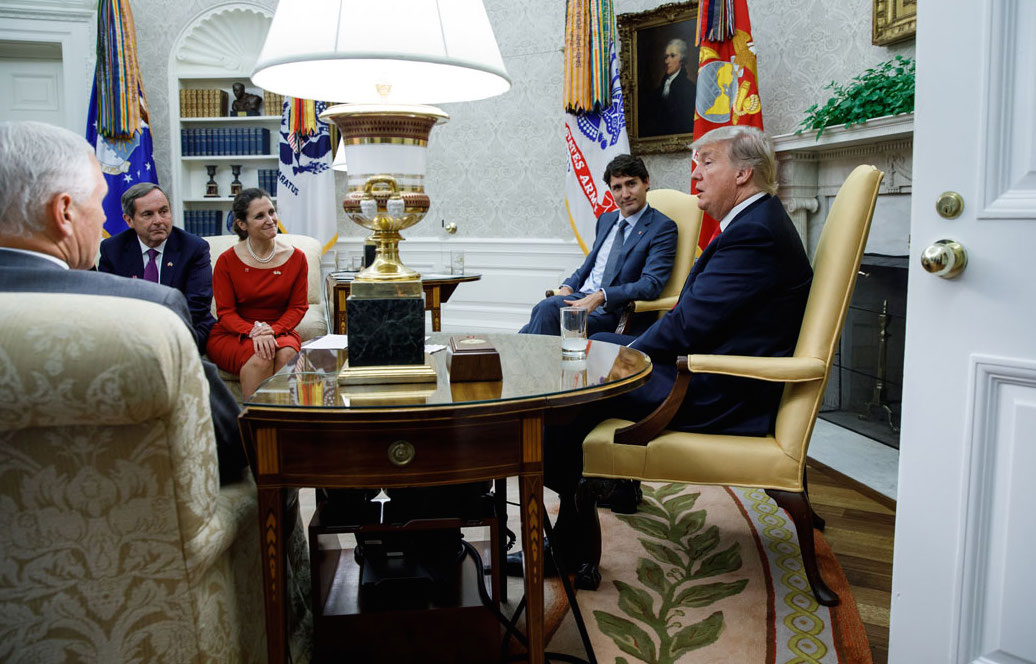After 500 days as U.S. president, Donald Trump is riding high, enjoying 87 per cent approval ratings from the 26 per cent of U.S citizens who declare as Republicans. This is more partisan support than any U.S. president has received since the Second World War, other than George W. Bush after 9/11.
While it is easy for Canadians to think of Trump as unfit and unqualified to be U.S. president, it is a mistake for the Trudeau government to ignore the way he keeps checking the boxes on his campaign pledges.
Whether it be pulling out of the Paris and Iran accords, moving the U.S. embassy to Jerusalem, expelling immigrants, or giving American corporations that invest in the U.S. a dollar for dollar tax benefit for each dollar invested, Trump is moving ahead on his partisan agenda.
Donald Trump was elected promising to deal with China and other American trading partners (think Canada and Mexico, its NAFTA partners), who were “stealing” American jobs.
The U.S. president currently has his sights on reversing trade flows with China and stopping intellectual property “theft.”
In preparing trade talks with China, Trump and his “America First” team of Commerce Secretary Wilbur Ross, U.S. Trade Representative Robert Lighthizer and White House National Trade Council Director Peter Navarro (author of Death by China) have gone on the offensive, brandishing tariffs of 25 per cent to be applied to a list of Chinese exports to the U.S.
The Trump administration has its own version of the “pivot to China” policy adopted by previous President Obama and Secretary Clinton.
Instead of encircling China with the Trans-Pacific Partnership, as the Democrats proposed, the Republicans have decided to force march their main trading partners into an anti-China alliance by imposing 25 per cent tariffs on U.S. steel imports and 10 per cent tariffs on aluminium imports.
These tariffs, met with incredulity by the Trudeau government, are designed to secure broad “co-operation” from U.S. trading partners by creating an atmosphere of fear about what the U.S. might do next if Canada and other trade partners do not fall in line behind the U.S. as it instigates a trade war with China.
Canada, with 26 per cent of the U.S. import market for steel and aluminium, expected as a NAFTA partner to be exempted from the tariffs when they were announced a month ago. But tariffs on Canada are part of a broader U.S. trade strategy of creating tensions with China.
For the steel and aluminium tariffs to be removed, the U.S. wants to be sure that Chinese exports are not arriving in the U.S. via third countries. Canada had hired 40 new officers and introduced new restrictions on imports to meet this U.S. concern. In addition, Canada is supposed to limit exports of steel and aluminium to 2017 levels.
The main U.S. demand is for Canada and other countries to join with it in punishing China for its trade practices. Early indications are that the U.S. plans to play tough to get its way.
The U.S. is prepared to protect its own auto market with a 25 per cent tariff on imports. Despite NAFTA, Canada can expect to see its automotive sector, which employs 140,000 people, hit with this 25 per cent tariff.
The 25 per cent figure is the amount that China, as a WTO non-market economy, decided to levy on auto imports.
The Americans want to force Canada, Mexico, the EU and other trading partners to apply U.S.-style 25 per cent protectionist tariffs against Chinese auto exports. In order to get its trading partners to play along with the anti-Chinese action, the U.S. will impose its own across-the-board 25 per cent tariff — which it will remove only when others agree to impose tariffs on China.
Canadians were led to believe by successive governments that it enjoyed free trade with the U.S. thanks to the 1988 Canada-U.S. bilateral trade deal and its successor, NAFTA. Yet, both these deals provided for full application of American protectionist trade law to cross-border commerce.
While the outrage in Ottawa and from the Canadian establishment and media is being directed at Trump, the action taken by the U.S. is very much in line with the way American authorities have acted historically when they want to exert their dominance over other countries.
The Chinese government has adopted an ambitious economic strategy: “Made in China 2025.” The idea is a planned transition from its sweatshop manufacturing industries into high tech sectors where currently China relies on imports from the U.S. and other nations.
There is still time for Canada to adopt a “Made in Canada” economic plan for the future.
Duncan Cameron is president emeritus of rabble.ca and writes a weekly column on politics and current affairs.
Photo: Adam Scotti/PMO




